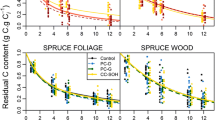Abstract
The decay rate of forest woody debris (WD) is a key missing link for a quantitative understanding of forest carbon dynamics and the global carbon budget. This paper reports an attempt to synthesize the available information into a unifying and testable numerical model pertinent to the analysis and projection of WD decay in field conditions. The model is rooted in an integrative theory that depicts decay as a process of substrate quality degradation along with feedback responses of microbial activity. It is parameterized through regression analysis against 112 data cases of stem and branch WD decay in North America, and then is evaluated against 132 additional data cases for stem and branch WD, and 75 data cases for root WD decay. The root mean square errors of both the fitted and the projected WD decay rates are about 14% of the means of respective data sets. Aided by peripheral algorithms, the model solves WD decay with data requirements limited to (1) tree species, and (2) air temperature and precipitation in January and July for forested sites, plus (3) latitude and elevation for deforested sites. The mathematical and physical implications of the model by its component functions and as a whole are generally supported by independent evidence from the literature where available. Those implications include: (1) the observed decay rate is lower when defined by density loss than by mass loss, when inferred from chronosequence survey than from population monitoring, or when estimated with specimens with end-coating than without coating; (2) the initial quality of WD differs between Abies/Picea and other species among conifers, or along the gradients of shade tolerance and normal stem slenderness among the deciduous trees; (3) the basic microbial growth rate (the rate at a WD quality of unity) increases with ambient temperature but decreases along the gradients of July precipitation-to-potential evapotranspiration ratio and January precipitation under forested conditions; and (4) WD decay may be accelerated or hampered after canopy removal, depending on local air humidity. The model further suggests that the lower of substrate quality and the basic microbial growth rate exerts a proportionally greater constraint on the decay rate, so the difference in WD decay by substrate and site narrows as the substrate quality degrades over time. Thus, a 2°C warming in air temperature would accelerate stem WD decay by 9–55% across the data sites for the 1st year, but only 1–14% by year 100.
Similar content being viewed by others
Author information
Authors and Affiliations
Additional information
Received: 7 January 1999 / Accepted: 23 June 1999
Rights and permissions
About this article
Cite this article
Yin, X. The decay of forest woody debris: numerical modeling and implications based on some 300 data cases from North America. Oecologia 121, 81–98 (1999). https://doi.org/10.1007/s004420050909
Issue Date:
DOI: https://doi.org/10.1007/s004420050909




